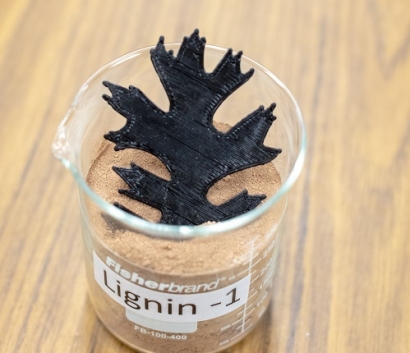
The discovery, detailed in Science Advances, expands ORNL’s achievements in lowering the cost of bioproducts by creating novel uses for lignin—the material left over from the processing of biomass. Lignin gives plants rigidity and also makes biomass resistant to being broken down into useful products.
“Finding new uses for lignin can improve the economics of the entire biorefining process,” said ORNL project lead Amit Naskar.
Researchers combined a melt-stable hardwood lignin with conventional plastic, a low-melting nylon, and carbon fiber to create a composite with just the right characteristics for extrusion and weld strength between layers during the printing process, as well as excellent mechanical properties.
Lignin chars easily and can only be heated to a certain temperature for softening and extrusion from a 3D-printing nozzle. Prolonged exposure to heat dramatically increases its viscosity—it becomes too thick to be extruded easily, making the research tricky.
But when researchers combined lignin with nylon, they found the composite’s room temperature stiffness increased while its melt viscosity decreased. The lignin-nylon material had tensile strength similar to nylon alone and lower viscosity, in fact, than conventional ABS or high impact polystyrene.
In fact, the combination of lignin and nylon “appeared to have almost a lubrication or plasticizing effect on the composite,” noted Naskar.
“Structural characteristics of lignin are critical to enhance 3D printability of the materials,” said ORNL’s Ngoc Nguyen who collaborated on the project.
Scientists were also able to mix in a higher percentage of lignin—40 to 50 percent by weight—a new achievement in the quest for a lignin-based printing material. ORNL scientists then added 4 to 16 percent carbon fiber into the mix. The new composite heats up more easily, flows faster for speedier printing, and results in a stronger product.
The lignin-nylon composite is patent-pending and work is ongoing to refine the material and find other ways to process it. The ORNL research team also included Sietske Barnes, Christopher Bowland, Kelly Meek, Kenneth Littrell and Jong Keum. The research was funded by DOE’s Office of Energy Efficiency and Renewable Energy’s Bioenergy Technologies Office.
ORNL is managed by UT-Battelle for the Department of Energy's Office of Science, the single largest supporter of basic research in the physical sciences in the United States.
Photo: Using as much as 50 percent lignin by weight, a new composite material created at ORNL is well suited for use in 3D printing. (ORNL)

